Welcome to our comprehensive guide on maximizing yields in Indian Jujube (Ber) orchards through month-wise operations. Jujube cultivation requires careful planning and timely execution of various tasks to ensure optimal productivity. This blog post works through a simplified and easy-to-follow month-wise operations guide to help you achieve higher yields from your Jujube orchards.
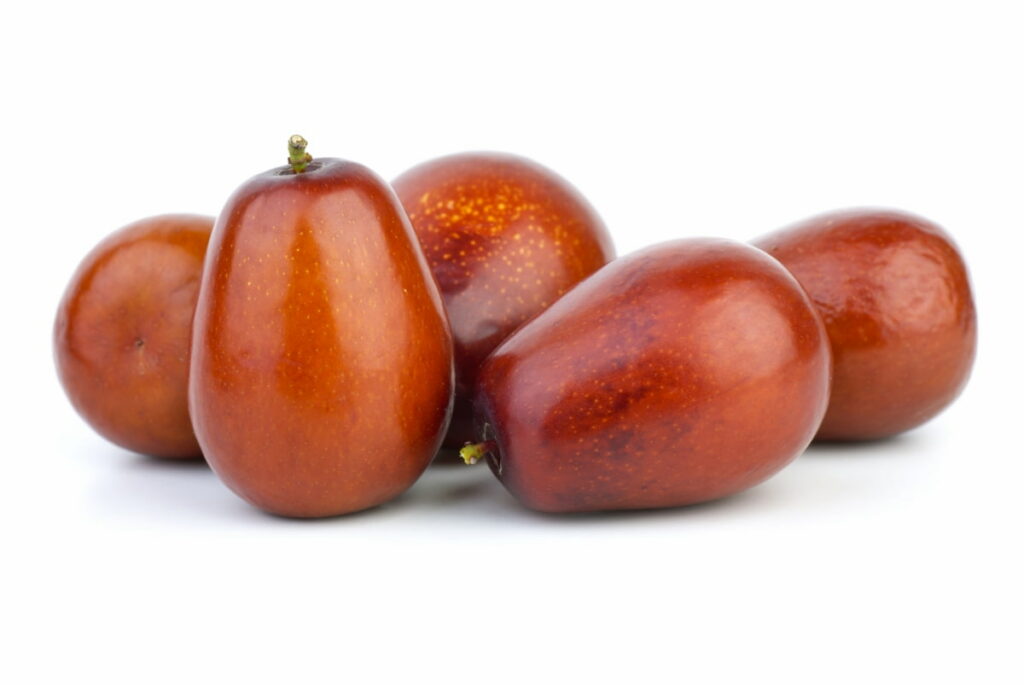
From pre-planting preparations and soil management to pruning techniques, pest and disease control, irrigation schedules, and harvest timings, we cover all aspects of Jujube orchard management.
Optimizing Indian Jujube/Ber Orchard Management
What is Indian Jujube (Ber) Farming and its Overview?
Indian Jujube (Ber), scientifically known as Ziziphus mauritiana, is a tropical fruiting tree that belongs to the Rhamnaceae family. It is commonly referred to by names such as Indian plum, Chinese date, Chinee apple, ber, and dunks. This fruit tree is often confused with the Chinese jujube, but they have different climate preferences. Indian Jujube is an evergreen shrub or small tree that reaches a height of 15 meters. It has spines, drooping branches, and a spreading crown.
The fruit varies in shape and size, ranging from oval to round and measuring 1-2.5 inches long. The fruit’s flesh is crisp and white, with a slight juiciness and pleasant aroma when slightly underripe. The fruit’s skin is smooth, glossy, thin, and tightly attached. Ber species is believed to have originated in the Indo-Malaysian region and has naturalized in various areas worldwide. Indian Jujube is a fast-growing tree with a medium lifespan, typically reaching heights of 10-40 feet.
Thanks to its rapidly developing taproot, it is known for its adaptability to drought conditions. The leaves of Indian Jujube are alternate, ovate, or oblong elliptic with rounded apex. The flowers are small, yellow, and usually appear in clusters of twos and threes in the leaf axils. The fruits are orange to brown, 2-3 centimeters long, and contain edible white pulp surrounding a pyrene with two seeds.
In case you missed it: Optimizing Cashew Orchard Management: A Month-by-Month Operation Guide for Maximum Yield
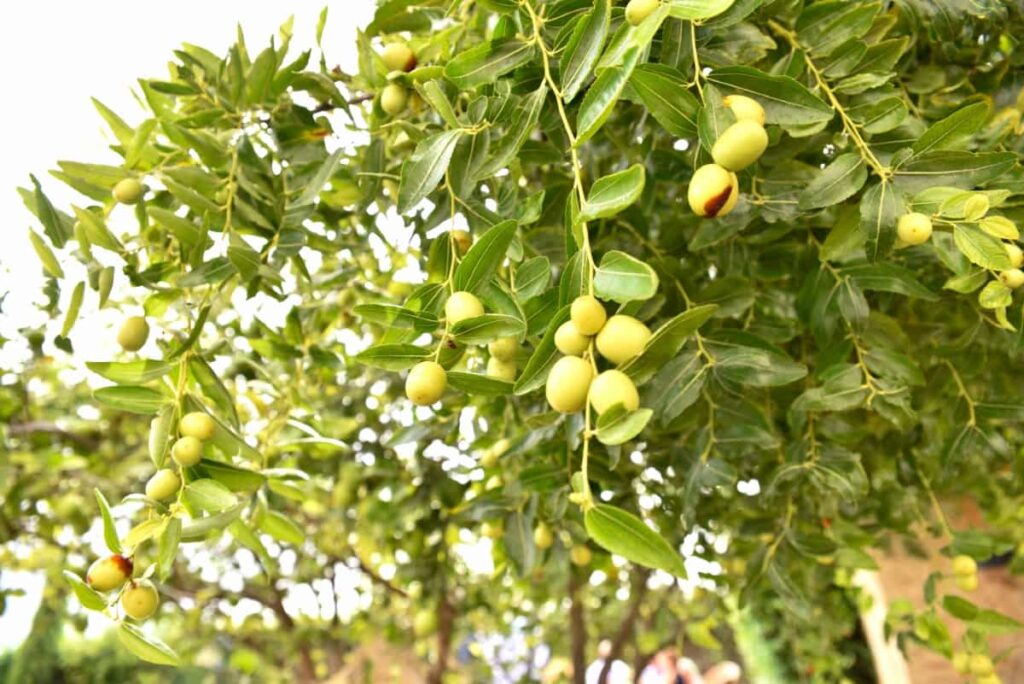
Indian Jujube farming thrives in tropical to subtropical climates, with annual rainfall ranging from 6 to 88.5 inches. The tree is highly tolerant of both waterlogging and drought. It prefers well-drained soils such as sandy loam or loamy soils with a slightly alkaline pH. Cross-pollination by insects is essential for fruit set, as the flowers are protandrous.
Importance of Month-Wise Planning for Indian Jujube (Ber) Orchard Operations
- Month-wise planning optimizes Indian Jujube orchard productivity by timing each operation from pre-planting to harvest.
- Pest and Disease Control: Monthly planning prevents and manages pest and disease outbreaks, protecting trees and produce.
- Resource Management: By scheduling activities by month, farmers may optimize irrigation, fertilizer, and labor use and reduce waste.
- Quality Fruit Production: Timing, pruning, thinning, and harvesting produces high-quality fruits with optimal flavor, texture, and color.
- Orchard Health: Month-by-month planning allows for frequent monitoring and management, improving the Jujube orchard’s health and lifespan.
Best Tips for Growing Indian Jujube (Ber) Orchard Operations Practices
Climate
- Indian Jujube is a hardy plant that can thrive in unfavorable climates. It prefers hot and dry conditions with adequate moisture during fruiting.
- The tree’s deep root system and xerophytic characteristics make it extremely drought-hardy.
- Excessive atmospheric humidity is not favorable for good fruiting.
- Grown up to an altitude of 1000m above mean sea level.
Soil
- Deep sandy loam soil is ideal for Indian Jujube cultivation.
- It can thrive under adverse conditions of salinity, drought, and waterlogging.
Varieties
- There are approximately 125 varieties of Indian Jujube found in India.
- Some important types include Umran, Gola, Seo, Mehroon, Kaithali, and Kantha.
- Varieties are classified based on their ripening period: early, mid-season, and late.
Propagation
- Seed propagation is possible but not preferred as the fruits produced are small and of poor quality.
- The most common commercial method of propagation is by I or T budding. Rootstock seedlings are raised by sowing seed kernels extracted from the stone.
- Budding is done during May-June on Zizyphus mauritiana rootstock.
Planting
- Spacing for rainfed orchards is 6 x 6 meters, while for irrigated orchards, it is 8 x 8 meters.
- Pits 60x60x60cm in size are dug and filled with soil, farmyard manure (FYM), and pesticides.
- Planting is typically done in June-August.
- Irrigation is required immediately after planting and during the fruit-bearing period (October-February).
- Intercropping with crops like mung and guar during the Kharif season and methi during the Rabi season can be practiced for up to 2 years.
Training and Pruning
- During the first 2-3 years, the trees should be trained to develop a strong framework.
- Annual pruning is essential to induce new healthy shoots and remove weak, diseased, and intercrossing branches.
- Pruning is done during the hot and dry season when the tree sheds leaves and enters dormancy.
- During the first 2-3 years, train Indian Jujube trees to develop a strong framework. Prune old growth in March, keeping 1-2 nodes above the graft union to stimulate new growth.
- Maintain a clean main trunk and remove undesirable branches. Prune during the hot and dry season, with light pruning of 25 buds being ideal. Remove secondary shoots and use thiourea or potassium nitrate to induce bud sprouting.
- The severity of pruning may vary based on location and climatic conditions.
In case you missed it: The Ultimate Month-by-Month Guide to Custard Apple Orchard Management
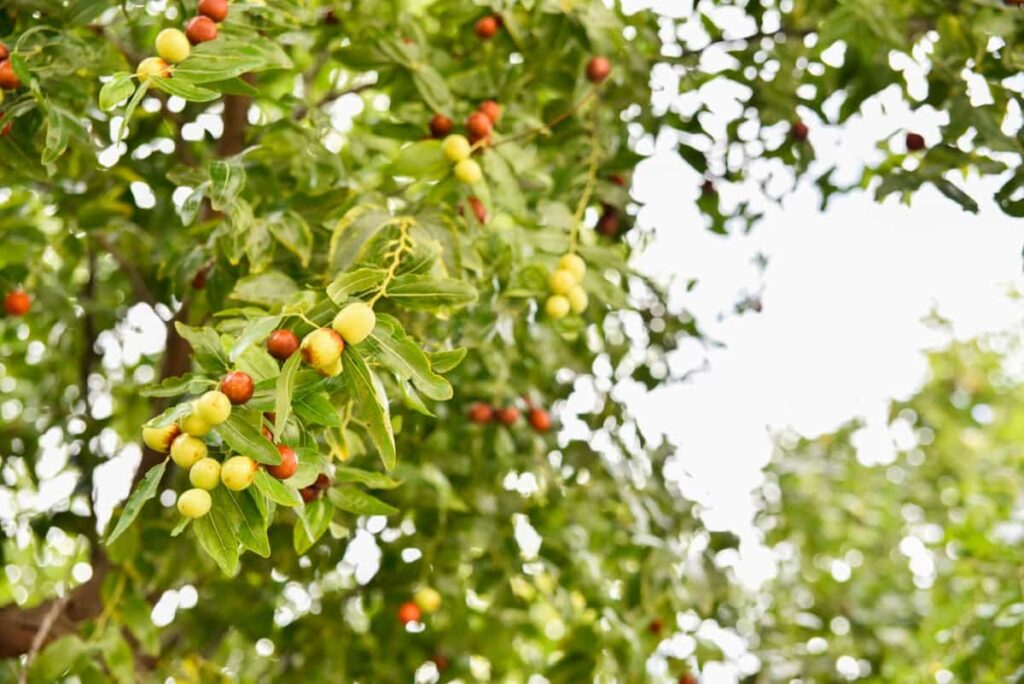
Manures and Fertilizers
- In July, FYM, NPK (nitrogen, phosphorus, and potassium), and micronutrients are applied to rainfed orchards.
- For irrigated orchards, FYM, phosphorus, potassium, and half of the nitrogen are applied in July, and the remaining nitrogen is used in September.
- For rainfed Indian Jujube orchards, apply 30 kg FYM, 100 g N, 50 g P2O5, and 50 g K2O in July. For irrigated orchards, apply 60 kg FYM, 500 g N, 400 g P2O5, and 400 g K2O in July and the remaining half of N in September.
Flowering and Harvesting
- Flowering occurs from the first week of September to the middle of November.
- Indian Jujube is a cross-pollinated crop.
- Harvesting takes place from February to April when the fruits have ripened properly.
- The yield varies depending on the variety, with early varieties yielding around 100 kg per tree, mid-season varieties yielding around 150 kg per tree, and late varieties like Umran yielding around 200 kg per tree.
Pest and Disease Management
- Fruit flies can be controlled by collecting and removing dropped fruits, deep plowing, and applying appropriate pesticides.
- Powdery mildew in Ber is a fungal disease that can be controlled by spraying wettable sulfur or fungicides at specific intervals.
In case you missed it: Optimizing Fig/Anjeer Orchard Management: A Month-by-Month Operation Guide for Maximum Yield
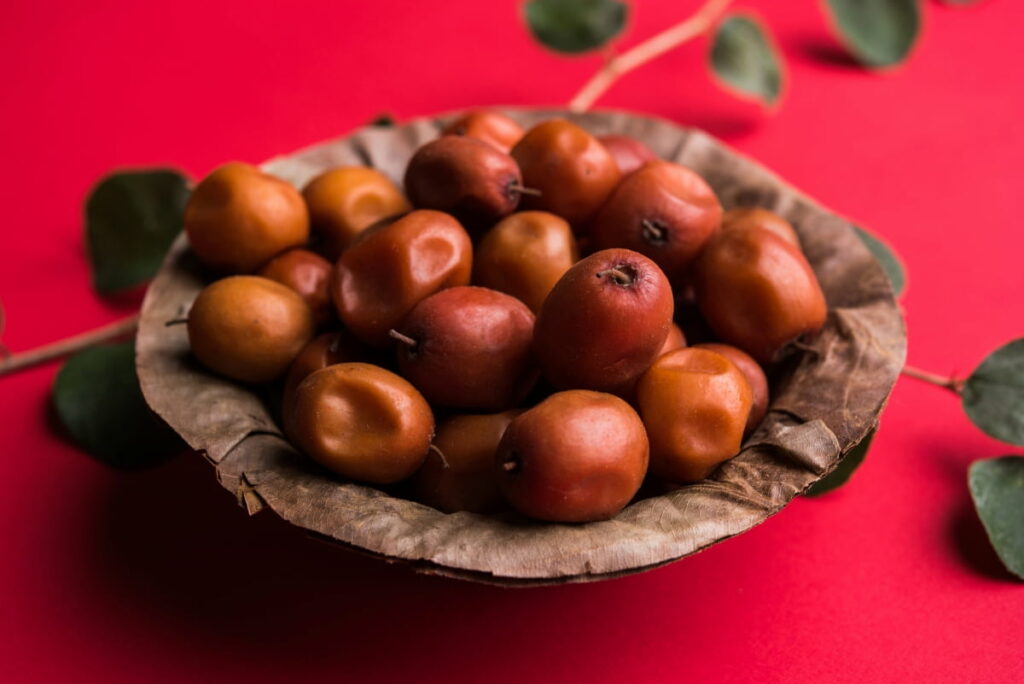
January Month Indian Jujube (Ber) Orchard Operations Planning
In January, focus on weeding, soil working, and mulching. Carry out weeding and soil work to improve aeration and control weeds. Mulch the basins with paddy husk, straw, groundnut shells, or other suitable mulching material. Mulching also helps control weeds in the basins.
February Month Indian Jujube (Ber) Orchard Operations Planning
In February, prioritize regular irrigation and pest control. Irrigate the plants for 5-7 days to ensure proper hydration. Check for stem and shoot borer incidence, which can cause significant damage. Inspect each plant periodically, removing borers from damaged shoots and injecting petrol or kerosene into the holes, then plugging them with mud or clay. Trap white flies, another common pest, by placing yellow cards or metal boxes with grease or sticky substances.
March Month Indian Jujube (Ber) Orchard Operations Planning
In March, apply fertilizers, irrigate, and address pest control. Apply fertilizers at least 6 inches from the plant and irrigate the pits immediately after application. Apply a basketful of mulch material to control evapotranspiration losses and weed growth in the basins.
April Month Indian Jujube (Ber) Orchard Operations Planning
In April, focus on regular irrigation and pest control. Ensure regular irrigation through a drip system or basins at 5-7 days intervals. Keep an eye on tender shoots, which may be susceptible to mealy bugs or white flies. Control these pests by spraying Acephate (1 gm/liter) or Dichlorovas (1 ml/liter of water).
It is crucial to assess the suitability of the soil for jujube orchards. Dig a profile pit of 3 x 3 x 3 ft to observe the soil characteristics. Avoid soils with calcareous nodules or sheet rock and waterlogged or poorly drained soils. Collect soil samples from different depths for testing. Test pH and Electric Conductivity. Ber trees start flowering.
May Month Indian Jujube (Ber) Orchard Operations Planning
During May, focus on land preparation. Conduct summer plowing twice using an MB plow to loosen the soil and create a suitable seedbed. Level the land to ensure uniformity. Align and mark pits with a spacing of 6.0 meters between rows. Make Dig pits of size 60 x 60 x 60 cm. While digging, keep the topsoil (1.5 ft.) to the right side of the pit and the bottom soil (1.5 ft.) to the left side.
Expose the pits to sunlight for at least two weeks before filling them, which helps control soil-borne pests and diseases. Procure plant material from reliable nurseries, preferably government nurseries or those recommended by the Department of Horticulture. Important varieties of Indian Jujube Orchards include Gola, Seo, Mehroon, Kaithali, Kantha, etc. They are classified into early (Gola, Seb, Safeda), mid-season (Kaithali, Reshmi), and late ripening (Umran, Kantha, Elaichi) types. Fruits begin to form and grow in size.
June Month Indian Jujube (Ber) Orchard Operations Planning
In June, the focus is on pit filling and further preparations. Fill the pits with a mixture of topsoil and organic amendments. Use 15 kgs of Farm Yard Manure (FYM), 1 kg of Single Super Phosphate, 1 kg of Neem Cake, and 100 gm of 10% Follidol dust per pit. Fill the pits with soil at least 6 inches above the ground level, allowing for settling.
In case you missed it: Optimizing Papaya Orchard Management: A Month-by-Month Operations Guide for Maximum Yield
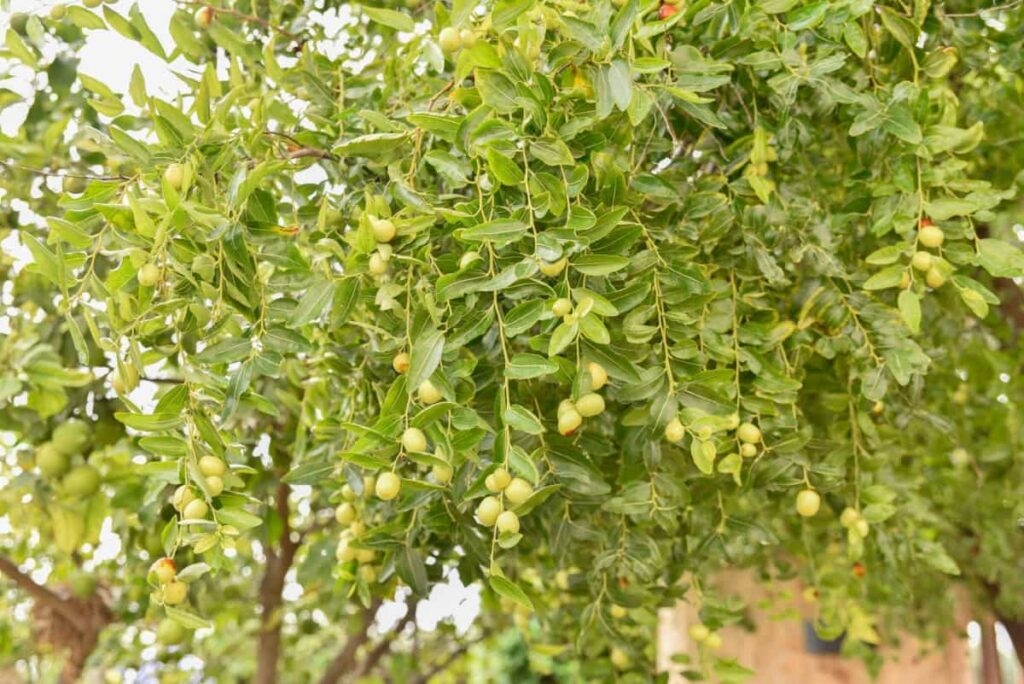
Install thorn fencing or any thick-growing live fence to control cattle trespassing. Mark out trench cutting for drip irrigation installation. Farmers can sow intercrops to maximize land utilization with the onset of the monsoon. Apply phosphorus-rich fertilizer to support fruit growth.
July Month Indian Jujube (Ber) Orchard Operations Planning
July is crucial for procuring plant material and planting the jujube layers. Procure recommended varieties from selected nurseries. Coordinate with farmers and Community Interest Group (CIG) members for transportation of plant material from the nursery to the plantation site.
Keep the layers near a water source and water them regularly until planting. If there is a delay in receiving adequate rainfall, provide irrigation or run the drip system to soak the pits. Plant the layers in the center of the pit without disturbing the root system’s ball of earth. Water the plants immediately after planting. Irrigate the plants for 4 to 5 days during the first month and later at 7 to 9 days if there is no rainfall during the initial two years.
August Month Indian Jujube (Ber) Orchard Operations Planning
In August, focus on weed control and water retention. Conduct weeding at least once a month during the monsoon season to control weeds. Simultaneously, create basins around the plants to retain water. To prevent evaporation and further weed growth, mulch the basins with paddy husk, straw, groundnut shells, or any other suitable dry organic matter.
Remove side shoots that emerge from the base of the plant up to a height of 50-75 cm. Continue monitoring fruit development and adjust irrigation and fertilization accordingly. If heavy rains persist and cause ill-drained conditions, provide drainage channels to avoid water stagnation, which can lead to yellowing leaves and plant wilting.
September Month Indian Jujube (Ber) Orchard Operations Planning
- In September, address micronutrient deficiencies if noticed. If deficiencies are observed, spray a solution containing 2 grams of Zinc Sulphate, 2 grams of Magnesium Sulphate, and 5 grams of Lime in 1 liter of water at 15-day intervals. Ber fruits start ripening.
- Harvest ripe fruits selectively and handle them carefully to avoid bruising. Work on the soils in the basins to keep them weed-free and improve aeration.
October Month Indian Jujube (Ber) Orchard Operations Planning
October is the time for gap-filling and pruning. If any gaps are noticed due to plant death, replace the plants by taking up gap filling. Prune the side shoots that appear from time to time at a height of 50-75 cm. Cut the growing shoot to encourage lateral branches, preferably in the east-west direction, to ensure better sunlight exposure. Continue harvesting mature fruits as they ripen. Farmers can sow intercrops for the rabi season during this month if intercrops were not cultivated during June-July.
November Month Indian Jujube (Ber) Orchard Operations Planning
- In November, focus on soil work, pruning, and irrigation. Work on the basins by loosening the soil and mulch with paddy straw, husk, groundnut shells, or any dry leaf matter to prevent weed growth.
- Prune the lower branches to a 50-75 cm height and cut the growing shoots to encourage lateral branches. Ensure regular irrigation at intervals of 7-10 days. Prune ber trees to remove deadwood, improve airflow, and maintain the desired shape.
- Apply organic mulch to protect the soil and provide nutrients.
December Month Indian Jujube (Ber) Orchard Operations Planning
December requires regular irrigation and addressing nutrient deficiencies. Continue regular irrigation at intervals of 7-10 days. Keep an eye out for the reddening of leaves due to phosphorus deficiency, which may occur due to low soil temperatures in winter. Correct this by spraying a 0.5% DAP (Di-Ammonium Phosphate) solution and frequently irrigating the basins.
In case you missed it: Optimizing Date Palm Orchard Management: A Month-by-Month Operations Guide for Maximum Yield

Conclusion
Implementing a well-planned month-wise operations guide for Indian Jujube (Ber) orchards is crucial for maximizing yields. Proper pruning, fertilization, pest control, and irrigation ensure healthy growth and abundant fruit production.
- Profitable Village Farming Business Ideas in 2024
- High-Yield Aquaculture: Fast-Growing Fish for Farming
- Effective Fish Pond Construction Techniques for Beginners
- Irrigation and Water Management in Pineapple Farming
- Blossom to Harvest: Mastering Flowering and Pollination in Papaya Farming
- Pig Fattening Essentials: From Selection to Sale for Beginners
- Raising Wagyu Cattle: A Complete Guide for Premium Beef Production
- Soil Types and Their Water Holding Capacity
- Optimizing Irrigation Schedules for Coconut Groves for Enhanced Yield
- Espresso Your Garden: Coffee Grounds for Healthier Acid-Loving Plants
- The Best Soil Mix for Snake Plants: How to Mix Your Own Snake Plant Soil
- Green Thumb Success: Expert Tips for Cultivating Greenhouse Beans All Year Round
- Bloom All Year Round: The Ultimate Guide to Indoor Hyacinth Care
- Eco-Friendly Gardening: How to Make Liquid Fertilizer from Kitchen Waste
- Ultimate Guide to Grow Anise in Pots: Explore Seed Propagation to Harvesting
- Guide to Raising Chester White Pigs: Discover Breed Facts to Growth Management
- Mastering the Elegance: The Ultimate Guide to Weeping Cherry Tree Care, Planting, and Maintenance
- Ultimate Guide to Planting Garlic in Grow Bags: Growing Strategies for Beginners
- How to Fix Spider Plant Leaf-Related Problems: Natural and Organic Remedies
- 10 Reasons Why Your Tulsi Plant is Shedding Leaves: Home Remedies and Solutions
- Optimizing Growth and Yield: The Advantages of Palm Bunch Ash Fertilizer
- Utilizing Neem Oil Extract as a Natural Pesticide for Hydrangea
- From Soil to Harvest: Various Ways in Which Farmers Can Use AI Tools
- Steps to Encourage and Induce Citrus Flowers: A Comprehensive Guide
- How to Fix Snake Plant Leaf-Related Issues: Natural and Organic Remedies
- Transform Your Garden into a Fragrant Oasis with Raat Ki Rani (Night Blooming Jasmine)
- Discover the Ideal Chicken Breeds for Philippine Farms
- How to Create a Poultry Egg Farm Business Plan for Profits
- Grow Lemon Cucumbers Like a Pro: Insider Techniques for Bountiful Yields
- Ultimate Guide to Caring for Your Pink Princess Philodendron: Tips for Thriving Variegation
- Areca Nut Profit Per Acre: Calculating Yield and Cost of Cultivation
- How Kaveri Chicken is Becoming a More Profitable Breed in Indian Backyards
- Transform Your Barn: 9 Steps to Convert a Horse Stall into a Chicken Coop
- Exploring Suffolk Sheep Disadvantages with Limitations and Challenges
- Guide to Solving Potted Lemon Tree Problems: How to Revive Lemon Tree in Containers
- Steps to Encourage Female Pumpkin Flowers: Best Strategies for More Flowers and High Yields
